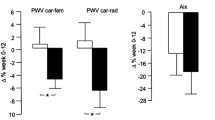Summary
The effects of changes in endogenous endothelium-derived nitric oxide (NO) on forearm blood flow and ex vivo platelet aggregation have been studied in 7 healthy volunteers.
Measurements were made of forearm blood flow and ex vivo collagen-stimulated platelet aggregation during unilateral brachial artery infusions of saline, acetylcholine (ACh), NG monomethyl-L-arginine (L-NMMA), and prostacyclin (PGI2). The uninfused arm acted as a control.
Forearm blood flow was increased by ACh, an agent which stimulates NO release, and decreased by L-NMMA, an agent which stereospecifically inhibits NO synthesis.
Collagen-stimulated platelet aggregation measured ex vivo in whole blood draining the infused arm was unaltered by either ACh or L-NMMA. Conversely, PGI2, an agent which acts independently of NO, caused an increase in forearm blood flow which was accompanied by significant inhibition of platelet aggregation.
The results suggest that release of endothelium-derived NO in quantities sufficient to cause substantial changes in blood vessel tone does not lead to changes in platelet aggregation in the blood flowing through the vessels. It is, however, still possible that endothelium-derived NO modulates platelet activity at the level of the endothelium.
Similar content being viewed by others
References
Vallance P, Collier J, Moncada S (1989) Effects of endothelium-derived nitric oxide on peripheral arteriolar tone in man. Lancet II: 997–1000
Busse R, Luckhoff A, Bassenge E (1987) Endothelium-derived relaxant factor inhibits platelet aggregation. Naunyn-Schmiedeberg's Arch Pharmacol 336: 566–571
Furlong B, Henderson AH, Lewis MJ, Smith JA (1987) Endothelium-derived relaxing factor inhibits in vitro platelet aggregation. Br J Pharmacol 90: 687–692
Radomski MW, Palmer RMJ, Moncada S (1987) Comparative pharmacology of endothelium-derived relaxing factor, nitric oxide and prostacyclin in platelets. Br J Phamacol 93: 181–187
Radomski MW, Palmer RMJ, Moncada S (1987) The antiaggregatory properties of vascular endothelium: interactions between prostacyclin and nitric oxide. Br J Pharmacol 92: 639–646
Radomski MW, Palmer RMJ, Moncada S (1987) Endogenous nitric oxide inhibits human platelet adhesion to vascular endothelium. Lancet II: 1057–1058
Palmer RMJ, Rees DD, Ashton DS, Moncada S (1988) L-arginine is the physiological precursor for the formation of nitric oxide in endothelium-dependent relaxation. Biochem Biophys Res Commun 153: 664–666
Lidbury PS, Antunes E, de Nucci G, Vane JR (1989) Interactions of iloprost and sodium nitroprusside on vascular smooth muscle and platelet aggregation. Br J Pharmacol 98: 1275–1280
Whitney RJ (1953) The measurement of volume changes in human limbs. J Physiol 121: 1–27
Flower RJ, Cardinal DC (1979) Use of a novel platelet aggregometer to study the generation by, and actions of, prostacyclin in whole blood. In: Vane JR, Bergstrom S (eds) Prostacyclin. Raven, New York
Ingerman-Wojenski C, Smith JB, Silver MJ (1983) Evaluation of electrical aggregometry: comparison with optical aggregometry, secretion of ATP, and accumulation of radio-labeled platelets. J Lab Clin Med 101: 44–52
Galvez A, Badimon L, Badimon J-J, Fuster V (1986) Electrical aggregometry in whole blood from human, pig and rabbit. Thromb Haem 56: 128–132
Riess H, Braun G, Brehm G, Hiller E (1985) Critical evaluation of platelet aggregation in whole human blood. Am J Clin Pathol 85: 50–56
Furchgott RF, Zadawzki JV (1980) The obligatory role of endothelial cells in the relaxation of arterial smooth muscle by acetylcholine. Nature 288: 373–376
Palmer RMJ, Ferrige AG, Moncada S (1987) Nitric oxide release accounts for the biological activity of endothelium-derived relaxing factor. Nature 327: 524–526
Hogan JC, Lewis MJ, Henderson AH (1988) In vivo EDRF activity influences platelet function. Br J Pharmacol 94: 1020–1022
Martin M, Villani GM, Jothianandan D, Furchgott RF (1985) Selective blockade of endothelium-dependent and glyceryl trinitrate-induced relaxation by haemoglobin and by methylene blue in the rabbit aorta. J Pharmacol Exp Ther 232: 708–716
Evans HG, Ryley HC, Hallett I, Lewis MJ (1989) Human red blood cells inhibit endothelium-derived relaxing factor (EDRF) activity. Eur J Pharmacol 163: 361–364
Edwards DH, Griffith TM, Ryley HC, Henderson AH (1986) Haptoglobin-haemoglobin complex in human plasma inhibits endothelium-dependent relaxation: evidence that endothelium-derived relaxing factor acts as a local autocoid. Cardiovasc Res 20: 549–556
Bhardwaj R, Moore PK (1987) Endothelium-dependent inhibition of human platelet aggregation in vitro. Br J Pharmacol 91: 402P
Pike NB, Watts IS, Lumley P (1990) Effects of guanylate cyclase activation and type I phosphodiesterase inhibition upon human platelet activation. Br J Pharmacol 99: 112P
Feelisch M, Noack EA (1987) Correlation between nitric oxide formation during degradation of organic nitrates and activation of guanylate cyclase. Eur J Pharmacol 139: 19–30
Gresele P, Zoja C, Deckmyn H, Arnout J, Vermylen J, Verstraete M (1983) Dipyridamole inhibits platelet aggregation in whole blood. Thromb Haemostas 50: 852–856
Alheid U, Reichwehr I, Forstermann U (1989) Human endothelial cells inhibit platelet aggregation by separately stimulating cyclic AMP and cyclic GMP. Eur J Pharmacol 164: 103–110
Benjamin N, Dutton JAE, Ritter JM (1990) Potentiation of anti-aggregatory effect of glyceryl trinitrate with cultured vascular smooth muscle cells. Arch Int Pharmacodyn Ther 305: 230
Hogan JC, Lewis MJ, Henderson AH (1989) Glyceryl trinitrate and platelet aggregation: effects of N-acetylcysteine. Br J Clin Pharmacol 27: 617–619
Ritter JM, Benjamin N, Doktor HS, Barrow SE, Mant TGK, Schey S, Stewart-Long P (1990) Effects of a selective thromboxane receptor antagonist (GR32191B) and of glyceryl trinitrate on bleeding time in man. Br J Clin Pharmacol 29: 431–436
Sinzinger H, Fitscha P, O'Grady J, Rauscha F, Rogatti W, Vane JR (1990) Synergistic effect of prostaglandin E1 and isosorbide dinitrate in peripheral vascular disease. Lancet 335: 627–628
Radomski MW, Palmer RMJ, Moncada S (1990) Characterization of the L-arginine to nitric oxide pathway in human platelets. Br J Pharmacol 101: 325–328
Author information
Authors and Affiliations
Additional information
Present address: Department of Medicine and Therapeutics, University of Aberdeen Polwarth Building, Forrester Hill, Aberdeen, UK
Rights and permissions
About this article
Cite this article
Vallance, P., Benjamin, N. & Collier, J. The effect of endothelium-derived nitric oxide on ex vivo whole blood platelet aggregation in man. Eur J Clin Pharmacol 42, 37–41 (1992). https://doi.org/10.1007/BF00314917
Received:
Accepted:
Issue Date:
DOI: https://doi.org/10.1007/BF00314917




